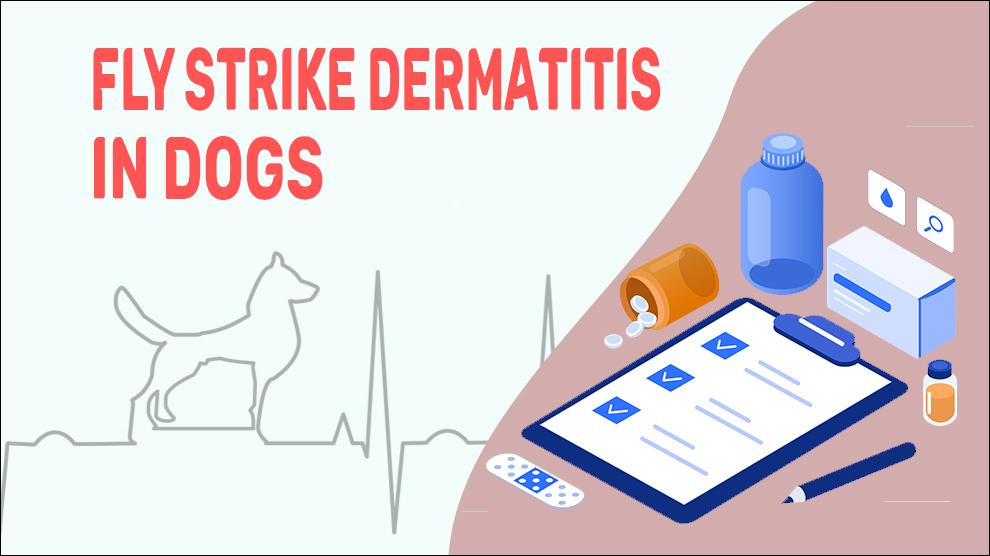What Is Fly Strike Dermatitis In Dogs?
Fly strike Dermatitis (FAD), also called myiasis is an irritation produced in a dog's ear in response to fly bites. Botflies, House flies, blowflies and flesh flies are the most common fly species that cause myiasis in dogs. These flies need an intermediate host for colonization in support of larval nourishment and growth.
Most commonly, Flystrike is rampant in the hotter months of the year. They usually affect pets with ongoing skin infections or open wounds. External parasites or animal bite wounds are also frequent spots of flystrike dermatitis in pets. Dogs that are unable to clean or groom themselves properly or dogs that have a concurrent illness are more inclined for being affected by flystrike dermatitis.
The open wounds of dogs, matted hairs, and ears of dogs are common egg-laying sites for flies. The newly cut umbilical cords of newborn puppies are also affected more often. Dogs with erect ears will generally have Mysiasis around the tip of the ear whereas hanging ears have Mysiasis on the front edge of the ear. When the face is involved, the severity of infection increases.
Matted hair regions that are contaminated are hotspots for flies to lay eggs and they will emerge into maggots or larvae. This will quickly transport to an infected or open wound to break in the skin. Invasion of the skin by the larvae is to consume infected or necrotic tissues near the skin. This predisposes the skin to secondary fungal and bacterial infections as well as causes pain and inflammation.
Symptoms Of Fly Strike Dermatitis In Dogs
- Visible larvae/maggots
- Reddening and thickening of the skin
- Red, bumps, sores on the skin
- Lethargy
- Decreased appetite
- Reluctance to move
- Foul smell from the purulent sores
- Patchy or inconsistent hair loss
- Painful, bloody ears
- Secondary bacterial and yeast infections
- Self-trauma
Treatment Options For Fly Strike Dermatitis In Dogs
Fly strike dermatitis treatment is multifactorial.
- Cleaning of open wounds with antibiotic solution.
- Debriding the wound is done to remove dead or necrotic tissues.
- Treatment includes a course of antibiotics, anti-inflammatory drugs, and pain relievers.
- Clindamycin - Antirobe/ClinCaps/ClinTabs (11-25 mg/kg PO) for 4 weeks, every 12 hours.
- Trimethoprim sulfadiazine- (15-30 mg/kg PO) for 4 weeks, every 12 hours.
- In combination with sulfadiazine or sulfamethoxazole or pyrimethamine (15 mg/kg PO for 4 weeks/ every 24 hours).
- To eradicate remaining maggots, a pyrethrin or pyrethroid-containing spray should be applied with caution to the lesions. Excess application may kill the debilitated dog.
- Ivermectin: 0.2 to 0.4 mg/kg SC or Fluralaner (Bravecto) 25 mg/kg administered is also effective against maggots.
Home Remedies For Fly Strike Dermatitis In Dogs
- Discourage the dog from wandering in fly-infested areas.
- Use pet-friendly anti microbial wipes.
- Clean food and water bowl daily.
- Use ointments/Creams to ease itching & irritation.
- Use Cold compresses when needed.
- For chewy or scratchy dogs, Consider using an inflatable/ Elizabethan collar.
Prevention Of Fly Strike Dermatitis In Dogs
- When you find out the place is infested with flies, avoidance is the best method of control.
- Insect repellant products to get rid of myiasis flies in the vicinity.
- Keep the fur/ears/mouth clean which is usually twice a day. Use medicated wipes containing a skin disinfectant.
- Neem sprays and Insect repellant collars can be used to repel insects.
- Dogs with skin folds can be cleaned daily with a clean, damp cloth, shampoo, wipes, ointment, lotion, spray, skin cleanser, etc.
Affected Dog Breeds Of Fly Strike Dermatitis
There is no breed or sex predisposition.
Additional Facts For Fly Strike Dermatitis In Dogs
1. Causes:
Fly larvae (Insecta, Diptera, and Arthropoda) in dogs.
2. Types:
Fly strike dermatitis can be classified as
Obligatory: Parasitic flies that require healthy host tissue (such as Furuncular Larvae – Penetrating healthy skin and developing furuncles).
Facultative: Pre-existing wound colonization often with necrotic or dead tissue.
Incidental/ accidental: Pseudoparasitosis or Accidental colonization of mucus membranes.
Biofilms: Colonization on invasive medical devices (catheters).
3. Mortality:
There is no documented mortality due to this condition.
4. Diagnosis:
- Complete blood count, chemistry panel
- Skin biopsy, fungal culture, bacterial culture
- Intradermal testing (IDT)
- Serological allergy testing using ELISA
5. Prognosis:
Depending on predisposing factors, the prognosis for fly strike dermatitis is good to guarded. Although the existing condition is not life-threatening, rigorous treatment is usually necessary. However, relapse will be a problem following medical treatment in affected dogs. Proper hygiene and home care are the best defenses against future recurrences.
When To See A Vet For Fly Strike Dermatitis In Dogs?
Contact your vet right away, if you notice any of the following:
- Visible larvae/maggots
- Reddening and thickening of the skin
- Red, raised, sores on the skin
Food Suggestions For Fly Strike Dermatitis In Dogs
A well-balanced diet is a precautionary measure for this condition.
- Avoid providing meals that might have fats.
- Omega3 fatty acids- Mackerel, Salmon, Herring, Sardines.
- Lean meats, such as chicken breast, sirloin, or pork.
- Leafy green vegetables, cauliflower, and broccoli.
- Low fat, high protein foods- White-Fleshed Fish, Skinless, White-Meat Poultry, Beans, Peas, and Lentils.
Conclusion
Treatment of Fly strike dermatitis is typically hard and may be partially, temporarily or entirely unsuccessful. Long periods (>2 months) of treatment may be needed. Early diagnosis and promptness of treatment is effective in many cases.

















